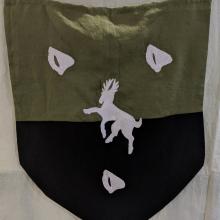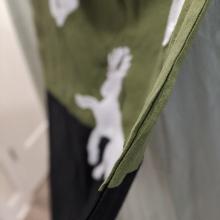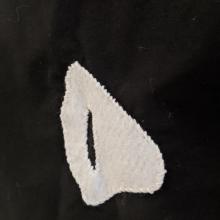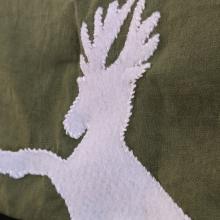This cape is based of of an Irish 'Brat' or mantle. Brats vary in length and shape but were generally affixed to the wearers shoulders with ties or brooches.
Brats could be worn alone or layered over one another to shield from different types of weather. Due to the variety of uses some Brats were plain while others were brightly colored or striped. Amount of color and materials used were largely dependent on the social status of the wearer.
Some images of Irish men wearing can be seen in The Book of Kells.
To make Lord Ronan's brat I used linen (green) and a tightly woven cotton (black) as the base fabrics. Since this brat is intended to be worn with chain maile on the heavy list fields longevity of the garment was one of my primary goals. To minimize ares where the chain maile can latch onto the brat, I used two layers of fabric to enclose the back of the applique.
In period brats would typically have been crafted out of wool or linen. Some wealthier Irishman would add fur, silk, or woven trim to their brats. The size would depend on the intended use and build of the wearer. I chose to make this brat the width of the wearers shoulders and as long as his torso. This size allows for clear display of arms, with minimal risk of the brat becoming entangled while Lord Ronan is fighting.
The applique is done in felt and applied with cotton thread. In period applique was done in felt as well as finished cloth and was affixed to garments with a variety of stitches including: whip stitch, blanket stitch, and running stitch.
Running Stich
Running stitch has been seen in ancient civilizations across the world, from as early as the Iron Age and has been found by archeologists throughout China, India, and Europe. Primarily used to reinforce seams an example of this stitch was found on a wool cushion in the Mammen grave site in Denmark (Viking Stitches and Motifs). Use of this stitch in Scandinavia is believed to pre-date the start of the Viking Age. Running stitch has high utility for reinforcing seams and thread is used very efficiently for this stitch.
The whole brat was assembled by hand, as it would have been in period, with a running stitch. The exact source of running stitch is unknown but extant pieces with this stitch have been found all over the world including: Scandinavia, the British Isles, and Asia.
The outward facing fabric panel is appliqued with Lord Ronan's device: per fess vert and sable, a stag rampant within three harps argent. The applique is done in felt, a method that was used in period for applique. Though my felt is synthetic felt instead of the felted wool used on period garment. Each element of the device is sewn in place with a whip stitch done in cotton thread. I chose to use cotton thread as it was the closest material I had to linen thread which would have been used in period.
I chose to hand sew the whole garment because my sewing machine was broken. This brat is intended for wear in combat and I am not yet confident enough to say that the strength of my hand sewn can match machine sewn seams. The final brat does benefit from the look of hand done seams, however the true test will be how well this brat holds up on the list fields.
Viking Embroidery and Motifs https://www.cs.vassar.edu/~capriest/vikembroid.html
Mammen Embroidery http://www.heatherrosejones.com/mammen/index.html
Hurstwich: Clothing in the Viking Age http://www.hurstwic.org/history/articles/daily_living/text/clothing.htm
History of Stitching https://classiccrossstitch.com/history.html
Dress and Costume in Ancient Ireland https://www.libraryireland.com/SocialHistoryAncientIreland/III-XVIII-2.php




